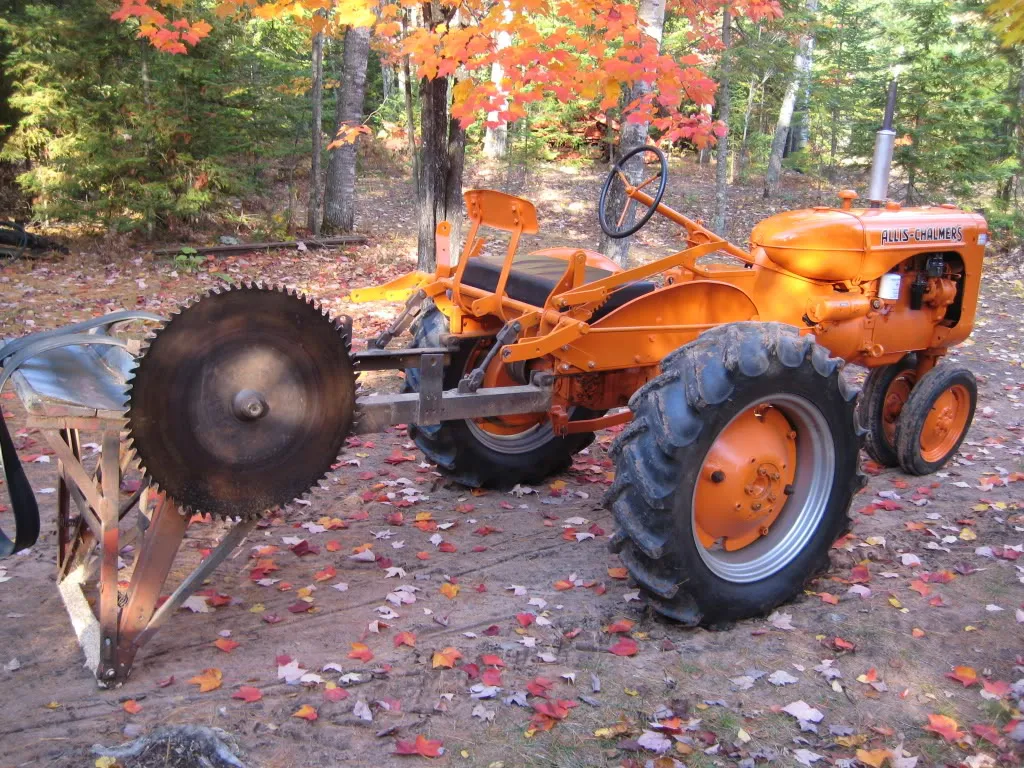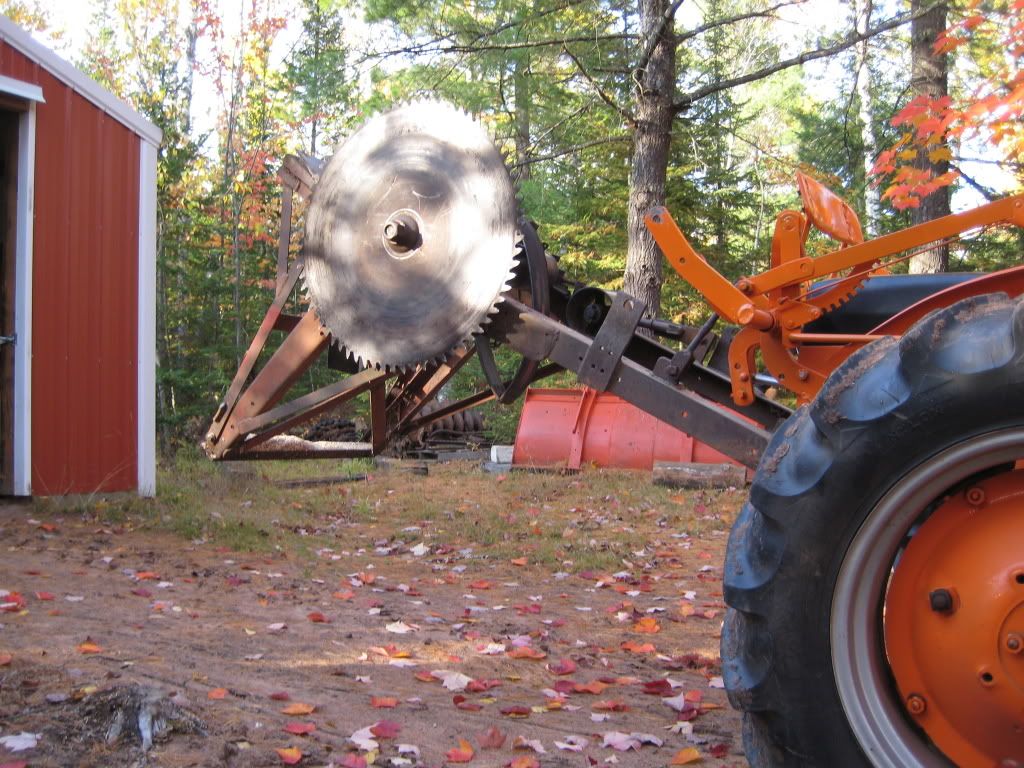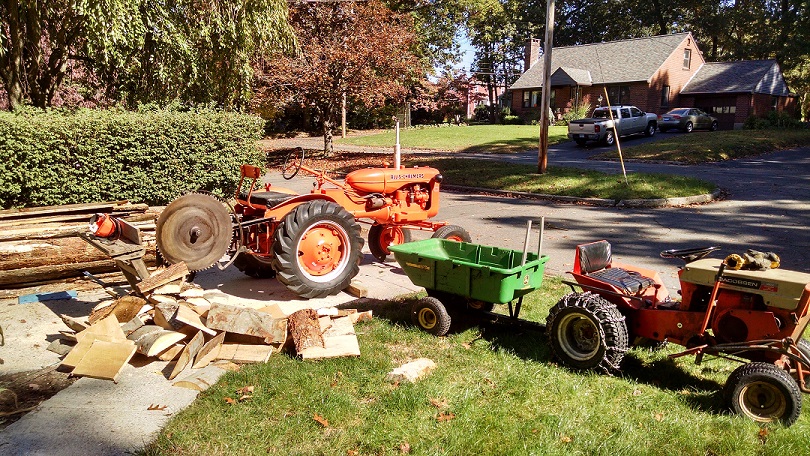Uses for belt pulleys,,,,
Printed From: Unofficial Allis
Category: Allis Chalmers
Forum Name: Farm Equipment
Forum Description: everything about Allis-Chalmers farm equipment
URL: https://www.allischalmers.com/forum/forum_posts.asp?TID=137174
Printed Date: 16 Dec 2025 at 7:25am
Software Version: Web Wiz Forums 11.10 - http://www.webwizforums.com
Topic: Uses for belt pulleys,,,,
Posted By: desertjoe
Subject: Uses for belt pulleys,,,,
Date Posted: 08 Apr 2017 at 10:18pm
|
My newest grandson, 15 months old, has developed a love for riding mowers, tractors and such. I been showin him some images of tractors on the web and I happened to see a couple of pics of tractors using the belt pulleys to drive what looks like a saw mill blade,,,, I'd like to see members tractors hooked up to different driven equipment,,,,I imagine they was used lots way back then,,not much any more,,,,???  |
Replies:
Posted By: Alberta Phil
Date Posted: 09 Apr 2017 at 9:37am
|
here is my '28 Allis 20-35 running a threshing machine last fall. |
Posted By: Gerald J.
Date Posted: 09 Apr 2017 at 10:30am
|
The front mounted and belt driven saw was used for cutting logs to firewood length. More powerful than two men on a cross cut saw, but less energy efficient than a chain saw but from a time period before affordable chain saws. Not the world's safest tool with so much saw blade exposed. Gerald J. |
Posted By: Jacob (WI,ND)
Date Posted: 09 Apr 2017 at 10:48am
|
If this works here is an old video of Dad and I using the home made buzz saw on the back of my C to cut up slab wood. http://s293.photobucket.com/user/pickupjake/media/IMG_0152.jpg.html" rel="nofollow">  What is nice about this rig is that the tractors hydraulics pick it up for transport. http://s293.photobucket.com/user/pickupjake/media/IMG_0149.jpg.html" rel="nofollow">  Is it dangerous? YOU BETCHA! Your only focus can be on where you are in relation to the blade on one of these things. But a chainsaw can be just as dangerous.
------------- Jacob Swanson 1920 6-12; 1925,1926 20-35 longfenders; 1925,1926 15-25's; 1927,1929 20-35 shortfenders; C; B's; IB; WC's; WD; WD45 |
Posted By: WF owner
Date Posted: 09 Apr 2017 at 4:37pm
| The buzz saws work great for sharpening cedar fence posts. |
Posted By: CTuckerNWIL
Date Posted: 09 Apr 2017 at 8:13pm
|
B254 cuttin a bit. https://goo.gl/photos/wgDjR3nDKr4Dv2L5A
------------- http://www.ae-ta.com" rel="nofollow - http://www.ae-ta.com Lena 1935 WC12xxx, Willie 1951 CA6xx Dad bought new, 1954WD45 PS, 1960 D17 NF |
Posted By: john2189
Date Posted: 09 Apr 2017 at 9:18pm
What is the purpose of useing such a long belt? Ive seen other set ups like that. john ------------- '41 Allis B '45 Allis B '49 Farmall Cub '72 IH Cub |
Posted By: ac fleet
Date Posted: 09 Apr 2017 at 10:39pm
| Long belts were used to aid in alingment and to keep from having to pull tight and pull machine over!!---Long belt don't slip as much either!! thanks; ac fleet |
Posted By: desertjoe
Date Posted: 10 Apr 2017 at 4:02am
|
I have always been very impressed with the enginuity that Americans use to make "do" when pressed with a job to do,,,,  and some of the "solutions" are just amazing,,,!!! I never knew what "Buzz saw" meant,,,,and now I know,,, and some of the "solutions" are just amazing,,,!!! I never knew what "Buzz saw" meant,,,,and now I know,,, They get the job done but dang does thet look dangerous,,,!! Whew,,,,,you dang sure wouldn't want to have to help while hungover,,and a little tipsey,,,,huh,,??? They get the job done but dang does thet look dangerous,,,!! Whew,,,,,you dang sure wouldn't want to have to help while hungover,,and a little tipsey,,,,huh,,??? If it was me,,,I'd have thet thing covered up like the provobial ,,,"OSHA Horse" ,,,,but it does get the job done,,don't it,,?? The farm I grew up on had 3 JDs and one IH (I think) and always wondered what the purpose of them things goin round all the time was for,,,,  Don't remember ever seein them used,, tho,,,, Don't remember ever seein them used,, tho,,,, |
Posted By: desertjoe
Date Posted: 10 Apr 2017 at 4:30am
|
Hey AC,, that makes sense on the longer belts for letting the weight keepin em snug and reducing slippage,  . .Mr Phil,,thet is a beautiful picture of a fall day at work,,, with winter on the way,,,,you ought to submit it for a calendar contest,,,,,  My caption would be,," Heavy clouds promising an early winter",,, My caption would be,," Heavy clouds promising an early winter",,, Hey Jacob,,,where is Kenmare from Bismark,,?? I've heard of it lots of times when headed to Belcourt,,but never knew where it was,,,,most of our "used to" trips up there were thru Black Hills, to Bismark, up to Minot, over to Rugby and north to Belcourt,,,I was always on the lookout for AC orange but never seen any,,,!! We drove right by ole Darrel's place lots of times before I knew where he lived,,,but,,next time,,I'm gonna stop in for coffee,,,,, I spent lots of time ridin up and down them country roads all the way to Langdon and Devil's Lake but never found anything,,course with all them trees,,,,,,, |
Posted By: Tbone95
Date Posted: 10 Apr 2017 at 7:09am
| Those belt pulleys are also used to rub the tread off the toes of your boots when you're young and dumb and screwing around while raking hay. |
Posted By: rpropst
Date Posted: 10 Apr 2017 at 8:09am
|
Long belt has a flywheel effect. Saw mills used them around here. With a long belt
the weight of the belt traveling between the pulleys acts like a flywheel. this helped the engine maintain speed when the log went into the saw.
------------- 1950 snap coupler B 1948 WD 1951Ca 1952B 1952adjustable axel B |
Posted By: Dakota Dave
Date Posted: 10 Apr 2017 at 8:19am
| Kenmare is west of Minot so its a long ways north west of Bismark. The twist in the belt also keeps the belt running in the center of the pulley. If you run t he belt flat it needs to be perfectly straight or the belt walks off the puleey. |
Posted By: Alberta Phil
Date Posted: 10 Apr 2017 at 9:42am
d.j. those clouds were more than threatinin'! We had to quit about an hour later as it started to rain and then snowed. We had an early winter and there are still close to a million acres of crops still in the fields according to the farm papers. And, Shameless must still have thet dang machine goin' , cause it's snowin here again!! |
Posted By: wfmurray
Date Posted: 10 Apr 2017 at 9:45am
| Twist in belt reverse the rotation.Dad had a buzz saw mounted on front of a W C . Open saw.Have off barid many hours next to that open saw. |
Posted By: Stan IL&TN
Date Posted: 10 Apr 2017 at 10:25am
|
Dad had a small corn grinder to grind hog feed mounted in a small building with a door that you would open up to run the belt out of to the tractor. Wish I had a picture of it. ------------- 1957 WD45 dad's first AC 1968 one-seventy 1956 F40 Ferguson |
Posted By: DanC911
Date Posted: 10 Apr 2017 at 10:50am

------------- 1950 WD, 1955 B, 66 Jacobsen Chief-O-Matic, 68 Simplicity 2110, 77 IH Cub Cadet 1450 w/front loader |
Posted By: DougS
Date Posted: 10 Apr 2017 at 11:01am
| The twist was done to reverse the direction of the driven pulley. We used the pulley on the WD to drive a front-mounted buzz saw, silo filler and hammer mill. We twisted the belt on the hammer mill and that was all. |
Posted By: Chad(WI)
Date Posted: 10 Apr 2017 at 12:39pm
| I remember my grandad telling me that a major reason for long drive belts was to gain distance from the dry straw to keep the risk of fire down from the steam engines that used to power the threshing machines. Obviously the long belts outlasted the steam engine. |
Posted By: Michael V (NM)
Date Posted: 10 Apr 2017 at 1:16pm
|
My Grandad tole me the longer the belt,, made more power, so I guess the flywheel effect has some truth to it. I also thought the long belt was to get sparking engines away from the straw pile... The twist I know reverses rotation,,, but steam engines have power both ways, what gives here? I can better understand that perfect alignment not needed with a twist |
Posted By: Bill Long
Date Posted: 10 Apr 2017 at 1:46pm
|
Don't forget the belt pulleys worked hammer mills - for grinding feed, enslige cutters, for chopping and tossing silage into the silo, blowers for blowing cut up silage into silos, generators - we sold a few belt operated generators and some PTO generators, in addition to sawmills. For information the belt pulley was standard on the WC and an option on the WD and up. I still remember an enslige (?) cutter at a demonstration. Nothing could pull it. I remember I looked on the side and saw the required rpms then measured the pulley on the cutter. I found that the pulleys mounted on the tractors were not getting the proper rpms to throw the enslige (?) - it really did not take all that power just rpms. I put the right size pulley on a flat top WC and went up the next day and worked the machine. Made a few sales that day. Simple mathematics. Good Luck! Bill Long |
Posted By: Gatz in NE
Date Posted: 10 Apr 2017 at 5:51pm
|
way back when, If we had a power outage (as would happen on occasion) our WC was used to run the vacuum pump for the Surge milkers. Had to milk them darn cows every morning and night, ya know. Dad had made a small access door on the barn, which allowed running a belt to the side pulley of the pump. We had a "buzz" saw too. It was mounted on the front of an F20. Every fall, we'd cut up short pieces of scrap wood for the kitchen stove. IIRC, it was direct, not twisted. The F20's belt pulley was rather large and could be mounted on either side. If you left the pulley on, get ready for some slow gear shifting.....always took a while to slow down. I always thought it strange that tractor mfgs never designed 'synchros into their transmissions.....until much later (60's ?) Guess it wasn't considered cost-effective. Was it JD that first had a synchronized transmission in the 3020 ? |
Posted By: Gerald J.
Date Posted: 10 Apr 2017 at 8:38pm
|
3010 and 4010 I think were synchro range. I know 3020 and 4020 were but had a power shift option too. I have a '68 gas 4020 SR. Gerald J. |
Posted By: shameless dude
Date Posted: 10 Apr 2017 at 9:20pm
| Joe...I have 2 drive on wagon hoists that are belt driven |
Posted By: Gatz in NE
Date Posted: 10 Apr 2017 at 9:35pm
yeah, now that you say that....I recall a cousin had bought a 4010 with synchro The Power Shift was first available on the 3020 ? |
Posted By: Gerald J.
Date Posted: 10 Apr 2017 at 9:46pm
|
Power shift was an new option on 3020 and 4020 that came out in 1963 simultaneously. 3020 and 4020 are different sizes, not ages. 3020 65 hp and 4020 93 or 95 hp. 4 cylinder vs 6 cylinder engines. Virtually identical hydraulics including steering by hydraulics, power brakes, and hydraulic operated differential lock. 3010 and 4020 used a poorer scheme for switching the PTO speed and splined shaft that caused more broken parts deep inside the transmission. The spline shaft bolts on and selects the speed according to a center rod in the mating flange. When the bolts work loose and it gets forced it breaks stuff inside. The 1969 model year of the 3020 and 4020 introduced a very different hydraulic system and moved the controls for the hydraulic remotes from the dash to a side console, hence they are often called "side console". There were so many differences that the two eras of 4020 don't share shop manuals or parts books, while the 4010 and 4020 do share both. Between the 4010, early 4020, and side console 4020 there are three different hydraulic remote connections and hardware. Gerald J. |
Posted By: JoeO(CMO)
Date Posted: 11 Apr 2017 at 6:22am
|
I think there is more belt contact area when the slack end is going away and using the long belt is more weight to better grip the pulley ------------- |
Posted By: Brian F(IL)
Date Posted: 11 Apr 2017 at 7:47am
| This was before my day, but the family used a belt on the 1936 WC to run the elevator to get ear corn and soybeans into the crib. Used tumbling rods and a speed jack to get the power to the elevator. Wish I had pictures, but I don't. |
Posted By: Dennis J OPKs
Date Posted: 11 Apr 2017 at 8:13am
| No photo but I remember a styled WC in the family that had a pulley driven loader. I think it was a clutch/cable unit. Later converted to hydraulic cylinders driven by a rear-mounted pto driven pump. It worked ok but required some skill since neither one was continuous/live operation although the WC had the drive train throw-out function. |
Posted By: WF owner
Date Posted: 11 Apr 2017 at 10:10am
|
The Amish in our area still use belt powered ensilage cutters to fill their silo(s). I have an Amish friend (he built my garage in 2011) who borrowed one of my WD-45's a couple years ago. I took my grandkids over to watch. They had 7 teams drawing corn with 2 men on each wagon. Each team brought in 5 loads before dinner and 6 loads after, for a total of 77 loads! They completely filled the silo that day. They put almost 30 gallons of gas through the WD-45. One of the Amish boys told me that they really liked using my tractor, because it had a lot of power. (They all seem to have old Case tractors.) They kept trying to plug the blower and cut the shear pins off in the table twice, but no plugs! |
Posted By: JimIA
Date Posted: 11 Apr 2017 at 3:10pm
|
A twisted belt is much more stable than a strait belt. One time at our local show we actually twisted a belt twice for an Oil Pull that had a pulley that ran a reverse direction. A strait belt is a scary sight, especially with a side wind. They will walk side to side like you wouldn't believe. Here is a pic of my WC at Hutch running the threshing machine. ------------- An open eye is much more observant than an open mouth |
Posted By: jb from md
Date Posted: 11 Apr 2017 at 7:31pm
here is a pic of my dad packing the bunker silo with a D17 they used to blow it up there and run it down after it got too high to push it up. pic taken around 1974- 1975 ------------- 8050 FWA, 190XT, 185, Styled wc, Unstyled wc, (2)C, (2)WD45NF, WD45WF, WD,416h, 716h, 312h, 8070 pedal. |
Posted By: Gatz in NE
Date Posted: 11 Apr 2017 at 9:56pm
|
can't recall just where I found this article, but it addresses the twisted belt topic very well. I think I was looking for some explanation of 'crowned pulleys' at the time. Twisted Belt Providing power to a threshing machine is a mix of science and
serendipity. |
Posted By: shameless dude
Date Posted: 11 Apr 2017 at 10:39pm
| I still have a stan-hoist elevator that is belt driven. I also have 2 drive on belt driven wagon hoists and somewhere a pump jack that was belt driven to run the elevator along with the knuckles and shafts. the hoists took place of the pump jack if the hoists were needed. also still have the belts that ran it all. we always had to use the same tractor that we hauled the loads in with to run the belt. got real good at aligning the belt up from each load in. |
Posted By: redline
Date Posted: 11 Apr 2017 at 10:44pm
|
I think it helped with steam engines to keep sparks from reaching the straw stack, too. I think it also helped make room for loads of shocks at the feeding conveyor. You could have a load on each side. One side would have to pitch over the belt, but still much faster. ------------- If it weren't for the last minute, I wouldn't get anything done! |
Posted By: JoeO(CMO)
Date Posted: 12 Apr 2017 at 6:53am
|
Good article Gatz! I remember some similar articles in some Steam Magazines, probably in my basement but didn't go look! ------------- |
 Alberta Phil wrote:
Alberta Phil wrote: